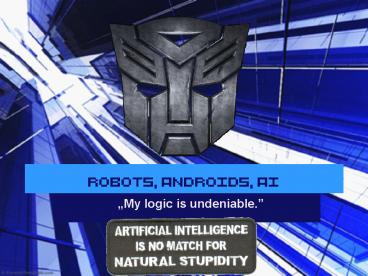Robots, Androids, AI - PowerPoint PPT Presentation
1 / 14
Title: Robots, Androids, AI
1
Robots, Androids, AI
- My logic is undeniable.
2
I, Robot
- The International Organization for
Standardization gives a definition of robot in
ISO 8373 an automatically controlled,
reprogrammable, multipurpose, manipulator
programmable in three or more axes, which may be
either fixed in place or mobile for use in
industrial automation applications. - The Robotics Institute of America (RIA) uses a
broader definition a robot is a re-programmable
multi-functional manipulator designed to move
materials, parts, tools, or specialized devices
through variable programmed motions for the
performance of a variety of tasks".
3
Once upon a time
- Likely fictional the Iliad illustrates the
concept of robotics by stating that the god
Hephaestus made talking mechanical handmaidens
out of gold. - Around 400 BC, Archytas of Tarentum is reputed to
have built a mechanical pigeon, possibly powered
by steam, capable of flying. - Leonardo Da Vinci designed a humanoid automaton
in knight's armor (Leonardo's robot) in 1495 to
entertain, but it is not known if the design was
ever built.
4
Robot? Never heard of it.
- The word robot was popularized by Czech author
Karel Capek in his 1921 play R.U.R. (Rossum's
Universal Robots). According to Karel, his
brother Josef was the actual inventor of the word
robot, creating the word from the Czech word
robota, meaning servitude. - In 1926, Fritz Lang's Metropolis was released
Maria (a main character) was the first robot seen
on film. - The world's first robot, a humanoid named Televox
operated through the telephone system, was
constructed in the United States in 1927. - In 1928, Makoto Nishimura produced Japan's first
robot, Gakutensoku.
5
Lets Make Robots
- The first electronic autonomous robots were
created by William Grey Walter of the Burden
Neurological Institute at Bristol, England in
1948 and 1949. They were named Elmer and Elsie.
These robots could sense light and contact with
external objects, and use these stimuli to
navigate. - The first truly modern robot, digitally operated
and programmable, was invented by George Devol in
1954 and was ultimately called the Unimate. Devol
sold the first Unimate to General Motors in 1960,
and it was installed in 1961 in a plant in
Trenton, New Jersey to lift hot pieces of metal
from a die casting machine and stack them.
6
The Robots are coming
- In 1984 Wabot-2 was revealed capable of playing
the organ, Wabot-2 had 10 fingers and two feet.
Wabot-2 was able to read a score of music and
accompany a person. - In 1999, Sony introduced the AIBO, a robotic dog
capable of interacting with humans, the first
models released in Japan sold out in 20 minutes. - Honda revealed the most advanced result of their
humanoid project in 2000, named ASIMO. ASIMO is
capable of running, walking, communication with
humans, facial and environmental recognition,
voice and posture recognition, and interacting
with its environment.
7
Robot Work
- Robots can be placed into roughly two
classifications based on the type of job they do.
- The first category includes tasks which a robot
can do better than a human. Here, robots can
increase productivity, accuracy, and endurance.
(In 2006, there were an estimated 3,540,000
service robots in use, and an estimated 950,000
industrial robots.) - The second category consists of dirty, dangerous
or dull jobs where it is desirable to replace
human labor with robotics. (There are many jobs
which humans would rather leave to robots. The
job may be boring, such as domestic cleaning, or
dangerous, such as exploring inside a volcano.
Other jobs are physically inaccessible, such as
exploring another planet, cleaning the inside of
a long pipe, or performing laparoscopic surgery.)
8
Robot Stories
- The most prolific author of stories about robots
was Isaac Asimov (19201992), who placed robots
and their interaction with society at the center
of many of his works. - Asimov carefully considered the problem of the
ideal set of instructions robots might be given
in order to lower the risk to humans, and arrived
at his Three Laws of Robotics - a robot may not injure a human being or, through
inaction, allow a human being to come to harm - a robot must obey orders given to it by human
beings, except where such orders would conflict
with the First Law - a robot must protect its own existence as long as
such protection does not conflict with the First
or Second Law. - Later, Asimov added the Zeroth Law A robot may
not harm humanity, or, by inaction, allow
humanity to come to harm the rest of the laws
are modified sequentially to acknowledge this.
9
I want to be human
- An android is a robot or synthetic organism
designed to look and act human. - A cyborg is a cybernetic organism (an organism
that has both artificial and natural systems). - A gynoid is a humanoid robot designed to look
like a human female.
10
- Artificial intelligence (AI) is the intelligence
of machines and the branch of computer science
which aims to create it. - Major AI textbooks define the field as the study
and design of intelligent agents, where an
intelligent agent is a system that perceives its
environment and takes actions which maximize its
chances of success. - John McCarthy, who coined the term in 1956,
defines it as the science and engineering of
making intelligent machines. - Artificial intelligence is used for logistics,
data mining, medical diagnosis and many other
areas throughout the technology industry.
11
(No Transcript)
12
These aren't the droids you're looking for
13
Can I keep it?
- Robots at work
- Robots at home
- Movies
- Sci-fi
- Books
- Etc
14
Thank you for your attention






























